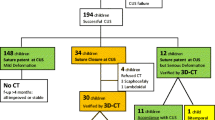Abstract
Background
Minimizing the ionizing radiation dose to children is fundamental to pediatric radiology. The most widely accepted imaging examination for evaluating craniosynostosis is computed tomography (CT) of the head, an examination that involves ionizing radiation.
Objective
To determine if sonography of the cranial sutures is an adequate screening examination for the diagnosis of craniosynostosis in patients with abnormal skull shape.
Materials and methods
A retrospective review of all cranial suture ultrasound (US) examinations performed during the course of a 3-year period (July 2012 – September 2015) was undertaken. Results were compared with clinical follow-up and/or head CT to evaluate the accuracy of this modality as a screening tool to determine the presence or absence of craniosynostosis. Fifty-two sonographic exams were adequate for inclusion.
Results
Forty-five of the examinations did not reveal synostosis. In each of these instances, follow-up physical exam findings and/or CT imaging confirmed that no abnormal premature suture closure was present. US findings demonstrated synostosis in seven cases. CT exam or operative reports of these cases confirmed all seven findings of premature suture closure. Statistical analysis demonstrated a sensitivity of 100% (95% confidence interval [CI]: 56.1–100.0%), a specificity of 100% (95% CI: 90.2–100.0%), and a negative predictive value of 100% (95% CI: 90.2–100.0%).
Conclusion
Cranial US is a reliable screening tool to rule out craniosynostosis in patients with abnormal head shape.







Similar content being viewed by others
References
Regelsberger J, Delling G, Tsokos M et al (2006) High-frequency ultrasound confirmation of positional plagiocephaly. J Neurosurg 105:413–417
McAlister WH (1998) Invited commentary: posterior deformational plagiocephaly. Pediatr Radiol 28:727–728
Laughlin J, Luerssen TG, Dias MS et al (2011) Prevention and management of positional skull deformities in infants. Pediatrics 128:1236–1241
Fernbach SK (1998) Craniosynostosis 1998: concepts and controversies. Pediatr Radiol 28:722–728
Badve CA, K MM, Iyer RS et al (2013) Craniosynostosis: imaging review and primer on computed tomography. Pediatr Radiol 43:728–742
Benson ML, Oliverio PJ, Yue NC et al (1996) Primary craniosynostosis: imaging features. AJR Am J Roentgenol 166:697–703
Regelsberger J, Delling G, Helmke K et al (2006) Ultrasound in the diagnosis of craniosynostosis. J Craniofac Surg 17:623–625
Schweitzer T, Bohm H, Meyer-Marcotty P et al (2012) Avoiding CT scans in children with single-suture craniosynostosis. Childs Nerv Syst 28:1077–1082
Medina LS, Richardson RR, Crone K (2002) Children with suspected craniosynostosis: a cost-effectiveness analysis of diagnostic strategies. AJR Am J Roentgenol 179:215–221
Hall EJ (2002) Lessons we have learned from our children: cancer risks from diagnostic radiology. Pediatr Radiol 32:700–706
Simanovsky N, Hiller N, Koplewitz B et al (2009) Effectiveness of ultrasonographic evaluation of the cranial sutures in children with suspected craniosynostosis. Eur Radiol 19:687–692
Soboleski D, McCloskey D, Mussari B et al (1997) Sonography of the normal cranial sutures. AJR Am J Roentgenol 168:819–821
Brenner DJ, Elliston C, Hall E et al (2001) Estimated risks of radiation-induced fatal cancer from pediatric CT. AJR Am J Roentgenol 176:289–296
Sze RW, Parisi MT, Sidhu M et al (2003) Ultrasound screening of the lambdoid suture in the child with posterior plagiocephaly. Pediatr Radiol 33:630–636
Rozovsky K, Udjus K, Wilson N et al (2016) Cranial ultrasound as a first-line imaging examination for craniosynostosis. Pediatrics 137:e20152230
Blaser SI (2008) Abnormal skull shape. Pediatr Radiol 38:S488–S496
Krimmel M, Will B, Wolff M et al (2012) Value of high-resolution ultrasound in the differential diagnosis of scaphocephaly and occipital plagiocephaly. Int J Oral Maxillofac Surg 41:797–800
Kim HJ, Roh HG, Lee IW (2016) Craniosynostosis: updates in radiologic diagnosis. J Korean Neurosurg Soc 59:219–226
Calandrelli R, D’Apolito G, Gaudino S et al (2014) Identification of skull base sutures and craniofacial anomalies in children with craniosynostosis: utility of multidetector CT. Radiol Med 119:694–704
Riera A, Chen L (2012) Ultrasound evaluation of skull fractures in children: a feasibility study. Pediatr Emerg Care 28:420–425
Weinberg ER, Tunik MG, Tsung JW (2010) Accuracy of clinician-performed point-or-care ultrasound for the diagnosis of fractures in children and young adults. Injury 41:862–868
Acknowledgements
The authors would like to thank Kathryn Leigh Foster for her assistance with the medical illustrations and Andrea F. McClynn for her assistance in the statistical analysis.
Author information
Authors and Affiliations
Corresponding author
Ethics declarations
Conflicts of interest
The views expressed in this article are those of the authors and do not necessarily reflect the official policy or position of the Department of the Navy, Department of Defense or the United States Government.
Research data derived from a Naval Medical Center, Portsmouth IRB/IACUC approved protocol, NMCP.2016.0013.
Drs. Hall, Besachio, Moore and Mora are military service members. This work was prepared as part of their official duties. Title 17 U.S.C. 105 provides that “Copyright protection under this title is not available for any work of the United States Government.” Title 17 U.S.C. 101 defines a United States Government work as a work prepared by a military service member or employee of the United States Government as part of that person’s official duties.
Rights and permissions
About this article
Cite this article
Hall, K.M., Besachio, D.A., Moore, M.D. et al. Effectiveness of screening for craniosynostosis with ultrasound: a retrospective review. Pediatr Radiol 47, 606–612 (2017). https://doi.org/10.1007/s00247-017-3793-1
Received:
Revised:
Accepted:
Published:
Issue Date:
DOI: https://doi.org/10.1007/s00247-017-3793-1




